Business Communication Skills: Article Review Report - Semester 1
VerifiedAdded on 2022/11/28
|6
|1987
|449
Report
AI Summary
This report provides a comparative review of two articles focusing on business communication and change management. The first article examines Kurt Lewin's three-step change model, critiquing its simplicity while acknowledging its foundational significance. It highlights the need for group-focused analysis, the use of new mathematics and statistics, and the importance of involving stakeholders. The second article emphasizes the necessity of updating change management strategies by incorporating digital tools. It argues that traditional methods are insufficient in today's fast-paced environment, and suggests digitizing areas like feedback, personalized experiences, and community building to enhance change efforts. The report compares and contrasts these perspectives, illustrating the complexities of change management and the evolving role of technology.
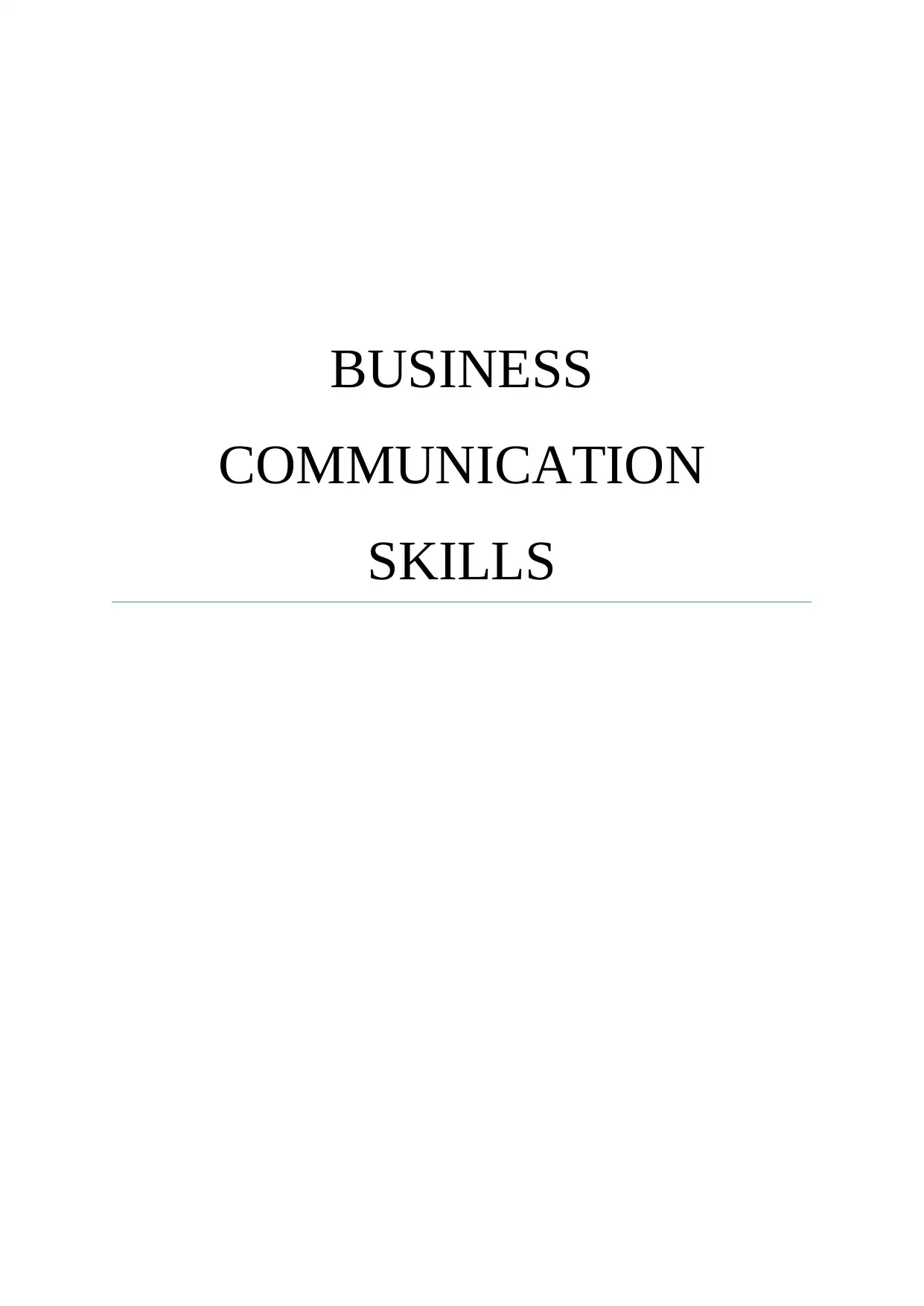
BUSINESS
COMMUNICATION
SKILLS
COMMUNICATION
SKILLS
Paraphrase This Document
Need a fresh take? Get an instant paraphrase of this document with our AI Paraphraser
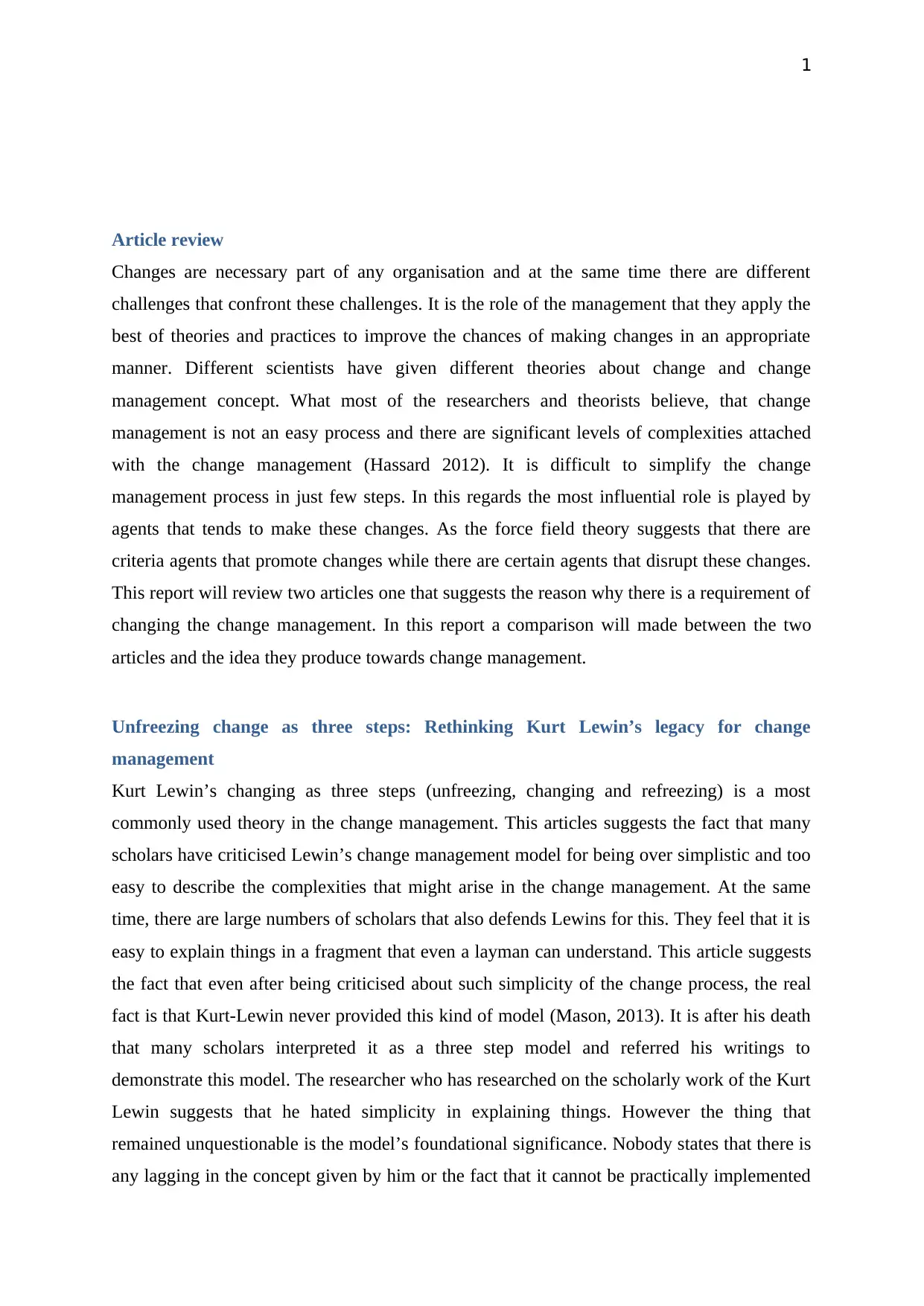
1
Article review
Changes are necessary part of any organisation and at the same time there are different
challenges that confront these challenges. It is the role of the management that they apply the
best of theories and practices to improve the chances of making changes in an appropriate
manner. Different scientists have given different theories about change and change
management concept. What most of the researchers and theorists believe, that change
management is not an easy process and there are significant levels of complexities attached
with the change management (Hassard 2012). It is difficult to simplify the change
management process in just few steps. In this regards the most influential role is played by
agents that tends to make these changes. As the force field theory suggests that there are
criteria agents that promote changes while there are certain agents that disrupt these changes.
This report will review two articles one that suggests the reason why there is a requirement of
changing the change management. In this report a comparison will made between the two
articles and the idea they produce towards change management.
Unfreezing change as three steps: Rethinking Kurt Lewin’s legacy for change
management
Kurt Lewin’s changing as three steps (unfreezing, changing and refreezing) is a most
commonly used theory in the change management. This articles suggests the fact that many
scholars have criticised Lewin’s change management model for being over simplistic and too
easy to describe the complexities that might arise in the change management. At the same
time, there are large numbers of scholars that also defends Lewins for this. They feel that it is
easy to explain things in a fragment that even a layman can understand. This article suggests
the fact that even after being criticised about such simplicity of the change process, the real
fact is that Kurt-Lewin never provided this kind of model (Mason, 2013). It is after his death
that many scholars interpreted it as a three step model and referred his writings to
demonstrate this model. The researcher who has researched on the scholarly work of the Kurt
Lewin suggests that he hated simplicity in explaining things. However the thing that
remained unquestionable is the model’s foundational significance. Nobody states that there is
any lagging in the concept given by him or the fact that it cannot be practically implemented
Article review
Changes are necessary part of any organisation and at the same time there are different
challenges that confront these challenges. It is the role of the management that they apply the
best of theories and practices to improve the chances of making changes in an appropriate
manner. Different scientists have given different theories about change and change
management concept. What most of the researchers and theorists believe, that change
management is not an easy process and there are significant levels of complexities attached
with the change management (Hassard 2012). It is difficult to simplify the change
management process in just few steps. In this regards the most influential role is played by
agents that tends to make these changes. As the force field theory suggests that there are
criteria agents that promote changes while there are certain agents that disrupt these changes.
This report will review two articles one that suggests the reason why there is a requirement of
changing the change management. In this report a comparison will made between the two
articles and the idea they produce towards change management.
Unfreezing change as three steps: Rethinking Kurt Lewin’s legacy for change
management
Kurt Lewin’s changing as three steps (unfreezing, changing and refreezing) is a most
commonly used theory in the change management. This articles suggests the fact that many
scholars have criticised Lewin’s change management model for being over simplistic and too
easy to describe the complexities that might arise in the change management. At the same
time, there are large numbers of scholars that also defends Lewins for this. They feel that it is
easy to explain things in a fragment that even a layman can understand. This article suggests
the fact that even after being criticised about such simplicity of the change process, the real
fact is that Kurt-Lewin never provided this kind of model (Mason, 2013). It is after his death
that many scholars interpreted it as a three step model and referred his writings to
demonstrate this model. The researcher who has researched on the scholarly work of the Kurt
Lewin suggests that he hated simplicity in explaining things. However the thing that
remained unquestionable is the model’s foundational significance. Nobody states that there is
any lagging in the concept given by him or the fact that it cannot be practically implemented
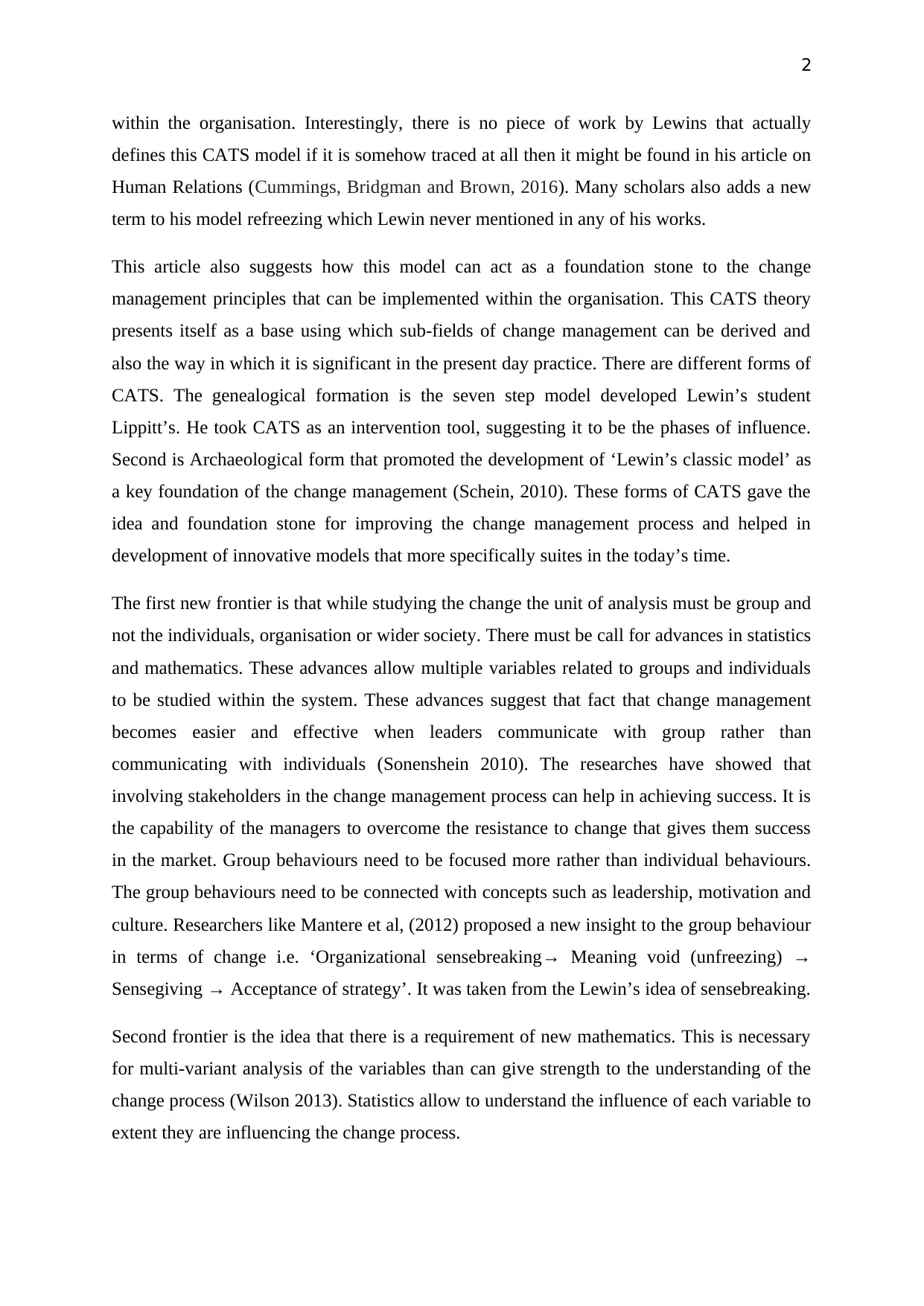
2
within the organisation. Interestingly, there is no piece of work by Lewins that actually
defines this CATS model if it is somehow traced at all then it might be found in his article on
Human Relations (Cummings, Bridgman and Brown, 2016). Many scholars also adds a new
term to his model refreezing which Lewin never mentioned in any of his works.
This article also suggests how this model can act as a foundation stone to the change
management principles that can be implemented within the organisation. This CATS theory
presents itself as a base using which sub-fields of change management can be derived and
also the way in which it is significant in the present day practice. There are different forms of
CATS. The genealogical formation is the seven step model developed Lewin’s student
Lippitt’s. He took CATS as an intervention tool, suggesting it to be the phases of influence.
Second is Archaeological form that promoted the development of ‘Lewin’s classic model’ as
a key foundation of the change management (Schein, 2010). These forms of CATS gave the
idea and foundation stone for improving the change management process and helped in
development of innovative models that more specifically suites in the today’s time.
The first new frontier is that while studying the change the unit of analysis must be group and
not the individuals, organisation or wider society. There must be call for advances in statistics
and mathematics. These advances allow multiple variables related to groups and individuals
to be studied within the system. These advances suggest that fact that change management
becomes easier and effective when leaders communicate with group rather than
communicating with individuals (Sonenshein 2010). The researches have showed that
involving stakeholders in the change management process can help in achieving success. It is
the capability of the managers to overcome the resistance to change that gives them success
in the market. Group behaviours need to be focused more rather than individual behaviours.
The group behaviours need to be connected with concepts such as leadership, motivation and
culture. Researchers like Mantere et al, (2012) proposed a new insight to the group behaviour
in terms of change i.e. ‘Organizational sensebreaking→ Meaning void (unfreezing) →
Sensegiving → Acceptance of strategy’. It was taken from the Lewin’s idea of sensebreaking.
Second frontier is the idea that there is a requirement of new mathematics. This is necessary
for multi-variant analysis of the variables than can give strength to the understanding of the
change process (Wilson 2013). Statistics allow to understand the influence of each variable to
extent they are influencing the change process.
within the organisation. Interestingly, there is no piece of work by Lewins that actually
defines this CATS model if it is somehow traced at all then it might be found in his article on
Human Relations (Cummings, Bridgman and Brown, 2016). Many scholars also adds a new
term to his model refreezing which Lewin never mentioned in any of his works.
This article also suggests how this model can act as a foundation stone to the change
management principles that can be implemented within the organisation. This CATS theory
presents itself as a base using which sub-fields of change management can be derived and
also the way in which it is significant in the present day practice. There are different forms of
CATS. The genealogical formation is the seven step model developed Lewin’s student
Lippitt’s. He took CATS as an intervention tool, suggesting it to be the phases of influence.
Second is Archaeological form that promoted the development of ‘Lewin’s classic model’ as
a key foundation of the change management (Schein, 2010). These forms of CATS gave the
idea and foundation stone for improving the change management process and helped in
development of innovative models that more specifically suites in the today’s time.
The first new frontier is that while studying the change the unit of analysis must be group and
not the individuals, organisation or wider society. There must be call for advances in statistics
and mathematics. These advances allow multiple variables related to groups and individuals
to be studied within the system. These advances suggest that fact that change management
becomes easier and effective when leaders communicate with group rather than
communicating with individuals (Sonenshein 2010). The researches have showed that
involving stakeholders in the change management process can help in achieving success. It is
the capability of the managers to overcome the resistance to change that gives them success
in the market. Group behaviours need to be focused more rather than individual behaviours.
The group behaviours need to be connected with concepts such as leadership, motivation and
culture. Researchers like Mantere et al, (2012) proposed a new insight to the group behaviour
in terms of change i.e. ‘Organizational sensebreaking→ Meaning void (unfreezing) →
Sensegiving → Acceptance of strategy’. It was taken from the Lewin’s idea of sensebreaking.
Second frontier is the idea that there is a requirement of new mathematics. This is necessary
for multi-variant analysis of the variables than can give strength to the understanding of the
change process (Wilson 2013). Statistics allow to understand the influence of each variable to
extent they are influencing the change process.
⊘ This is a preview!⊘
Do you want full access?
Subscribe today to unlock all pages.

Trusted by 1+ million students worldwide
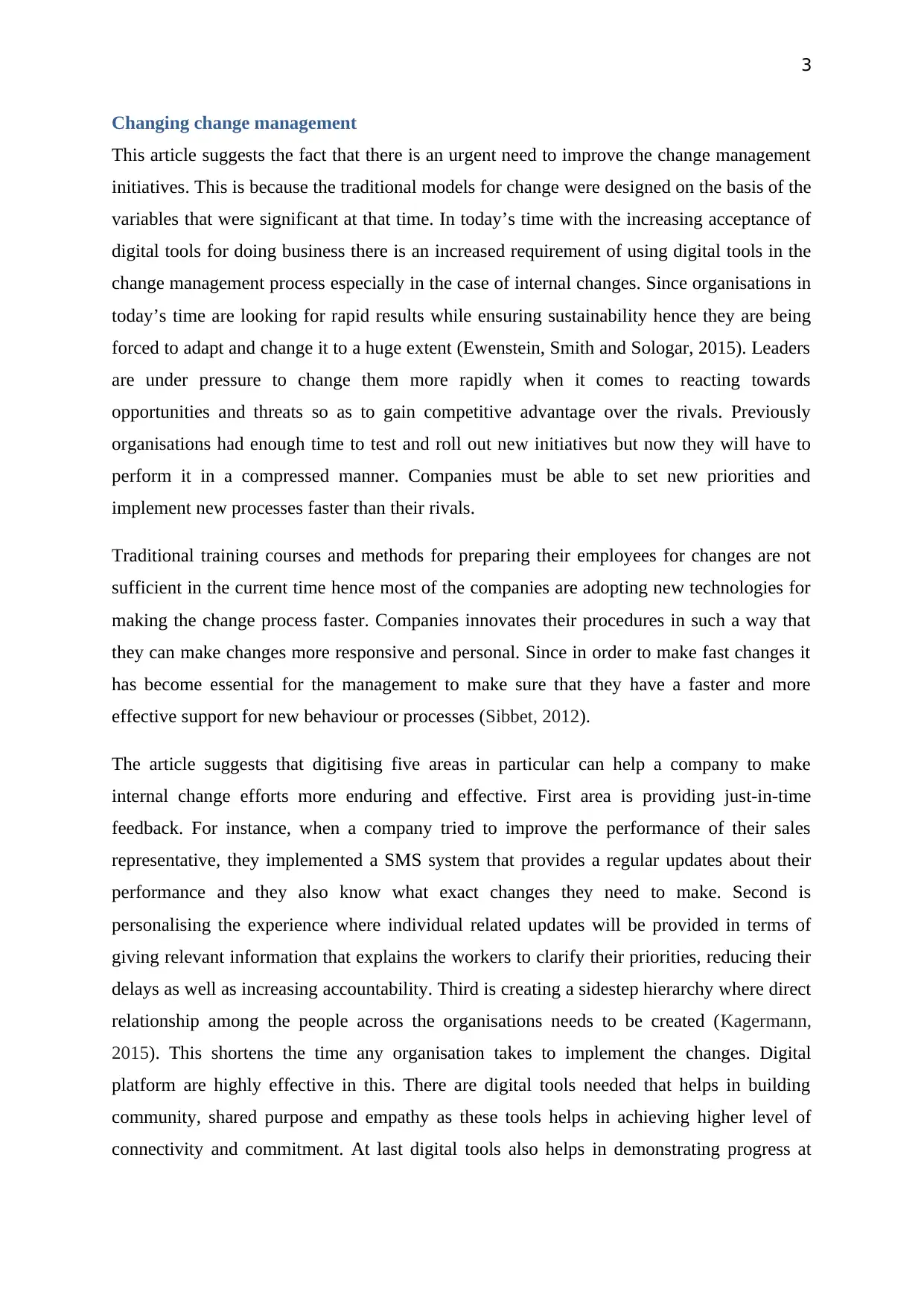
3
Changing change management
This article suggests the fact that there is an urgent need to improve the change management
initiatives. This is because the traditional models for change were designed on the basis of the
variables that were significant at that time. In today’s time with the increasing acceptance of
digital tools for doing business there is an increased requirement of using digital tools in the
change management process especially in the case of internal changes. Since organisations in
today’s time are looking for rapid results while ensuring sustainability hence they are being
forced to adapt and change it to a huge extent (Ewenstein, Smith and Sologar, 2015). Leaders
are under pressure to change them more rapidly when it comes to reacting towards
opportunities and threats so as to gain competitive advantage over the rivals. Previously
organisations had enough time to test and roll out new initiatives but now they will have to
perform it in a compressed manner. Companies must be able to set new priorities and
implement new processes faster than their rivals.
Traditional training courses and methods for preparing their employees for changes are not
sufficient in the current time hence most of the companies are adopting new technologies for
making the change process faster. Companies innovates their procedures in such a way that
they can make changes more responsive and personal. Since in order to make fast changes it
has become essential for the management to make sure that they have a faster and more
effective support for new behaviour or processes (Sibbet, 2012).
The article suggests that digitising five areas in particular can help a company to make
internal change efforts more enduring and effective. First area is providing just-in-time
feedback. For instance, when a company tried to improve the performance of their sales
representative, they implemented a SMS system that provides a regular updates about their
performance and they also know what exact changes they need to make. Second is
personalising the experience where individual related updates will be provided in terms of
giving relevant information that explains the workers to clarify their priorities, reducing their
delays as well as increasing accountability. Third is creating a sidestep hierarchy where direct
relationship among the people across the organisations needs to be created (Kagermann,
2015). This shortens the time any organisation takes to implement the changes. Digital
platform are highly effective in this. There are digital tools needed that helps in building
community, shared purpose and empathy as these tools helps in achieving higher level of
connectivity and commitment. At last digital tools also helps in demonstrating progress at
Changing change management
This article suggests the fact that there is an urgent need to improve the change management
initiatives. This is because the traditional models for change were designed on the basis of the
variables that were significant at that time. In today’s time with the increasing acceptance of
digital tools for doing business there is an increased requirement of using digital tools in the
change management process especially in the case of internal changes. Since organisations in
today’s time are looking for rapid results while ensuring sustainability hence they are being
forced to adapt and change it to a huge extent (Ewenstein, Smith and Sologar, 2015). Leaders
are under pressure to change them more rapidly when it comes to reacting towards
opportunities and threats so as to gain competitive advantage over the rivals. Previously
organisations had enough time to test and roll out new initiatives but now they will have to
perform it in a compressed manner. Companies must be able to set new priorities and
implement new processes faster than their rivals.
Traditional training courses and methods for preparing their employees for changes are not
sufficient in the current time hence most of the companies are adopting new technologies for
making the change process faster. Companies innovates their procedures in such a way that
they can make changes more responsive and personal. Since in order to make fast changes it
has become essential for the management to make sure that they have a faster and more
effective support for new behaviour or processes (Sibbet, 2012).
The article suggests that digitising five areas in particular can help a company to make
internal change efforts more enduring and effective. First area is providing just-in-time
feedback. For instance, when a company tried to improve the performance of their sales
representative, they implemented a SMS system that provides a regular updates about their
performance and they also know what exact changes they need to make. Second is
personalising the experience where individual related updates will be provided in terms of
giving relevant information that explains the workers to clarify their priorities, reducing their
delays as well as increasing accountability. Third is creating a sidestep hierarchy where direct
relationship among the people across the organisations needs to be created (Kagermann,
2015). This shortens the time any organisation takes to implement the changes. Digital
platform are highly effective in this. There are digital tools needed that helps in building
community, shared purpose and empathy as these tools helps in achieving higher level of
connectivity and commitment. At last digital tools also helps in demonstrating progress at
Paraphrase This Document
Need a fresh take? Get an instant paraphrase of this document with our AI Paraphraser
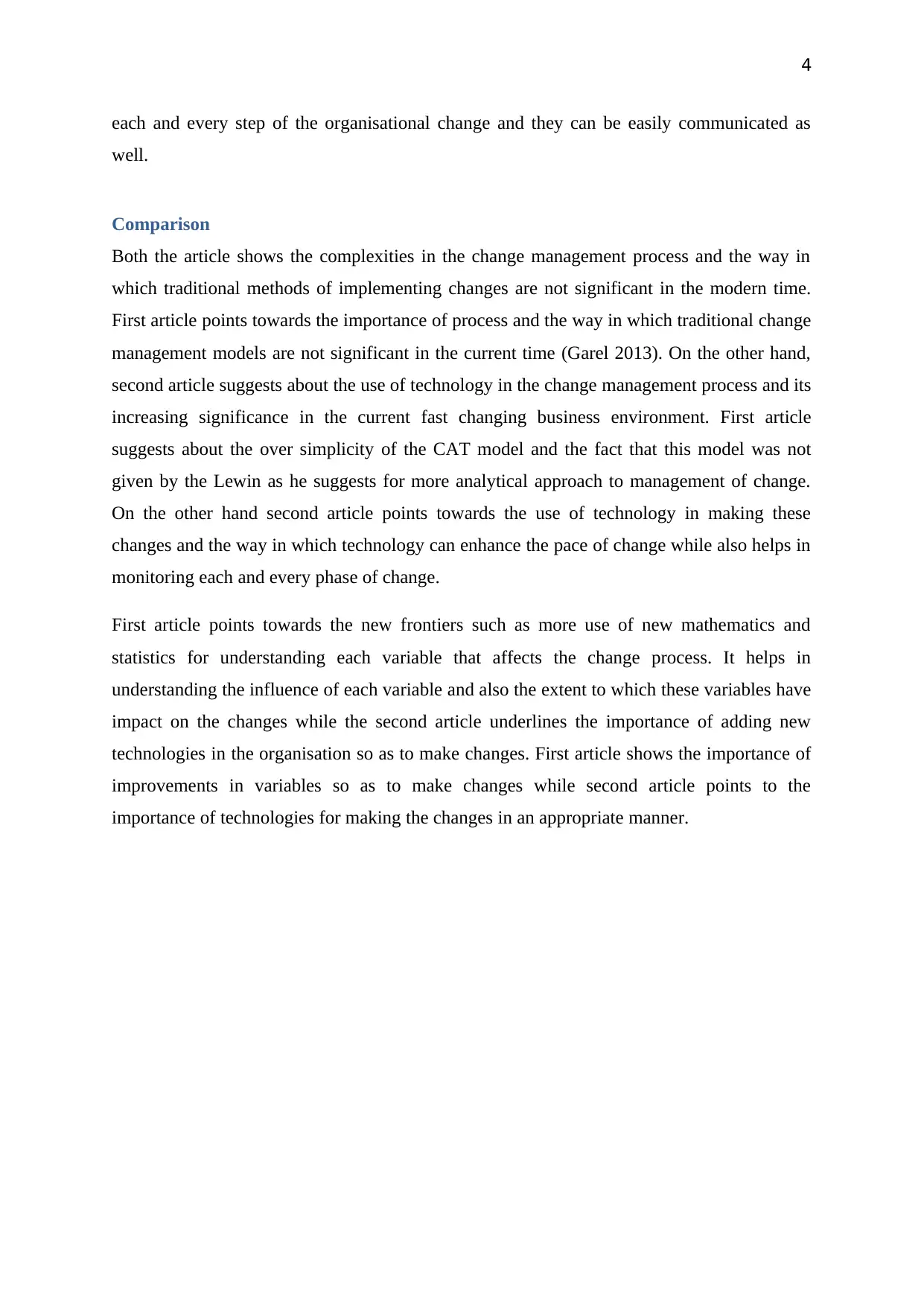
4
each and every step of the organisational change and they can be easily communicated as
well.
Comparison
Both the article shows the complexities in the change management process and the way in
which traditional methods of implementing changes are not significant in the modern time.
First article points towards the importance of process and the way in which traditional change
management models are not significant in the current time (Garel 2013). On the other hand,
second article suggests about the use of technology in the change management process and its
increasing significance in the current fast changing business environment. First article
suggests about the over simplicity of the CAT model and the fact that this model was not
given by the Lewin as he suggests for more analytical approach to management of change.
On the other hand second article points towards the use of technology in making these
changes and the way in which technology can enhance the pace of change while also helps in
monitoring each and every phase of change.
First article points towards the new frontiers such as more use of new mathematics and
statistics for understanding each variable that affects the change process. It helps in
understanding the influence of each variable and also the extent to which these variables have
impact on the changes while the second article underlines the importance of adding new
technologies in the organisation so as to make changes. First article shows the importance of
improvements in variables so as to make changes while second article points to the
importance of technologies for making the changes in an appropriate manner.
each and every step of the organisational change and they can be easily communicated as
well.
Comparison
Both the article shows the complexities in the change management process and the way in
which traditional methods of implementing changes are not significant in the modern time.
First article points towards the importance of process and the way in which traditional change
management models are not significant in the current time (Garel 2013). On the other hand,
second article suggests about the use of technology in the change management process and its
increasing significance in the current fast changing business environment. First article
suggests about the over simplicity of the CAT model and the fact that this model was not
given by the Lewin as he suggests for more analytical approach to management of change.
On the other hand second article points towards the use of technology in making these
changes and the way in which technology can enhance the pace of change while also helps in
monitoring each and every phase of change.
First article points towards the new frontiers such as more use of new mathematics and
statistics for understanding each variable that affects the change process. It helps in
understanding the influence of each variable and also the extent to which these variables have
impact on the changes while the second article underlines the importance of adding new
technologies in the organisation so as to make changes. First article shows the importance of
improvements in variables so as to make changes while second article points to the
importance of technologies for making the changes in an appropriate manner.
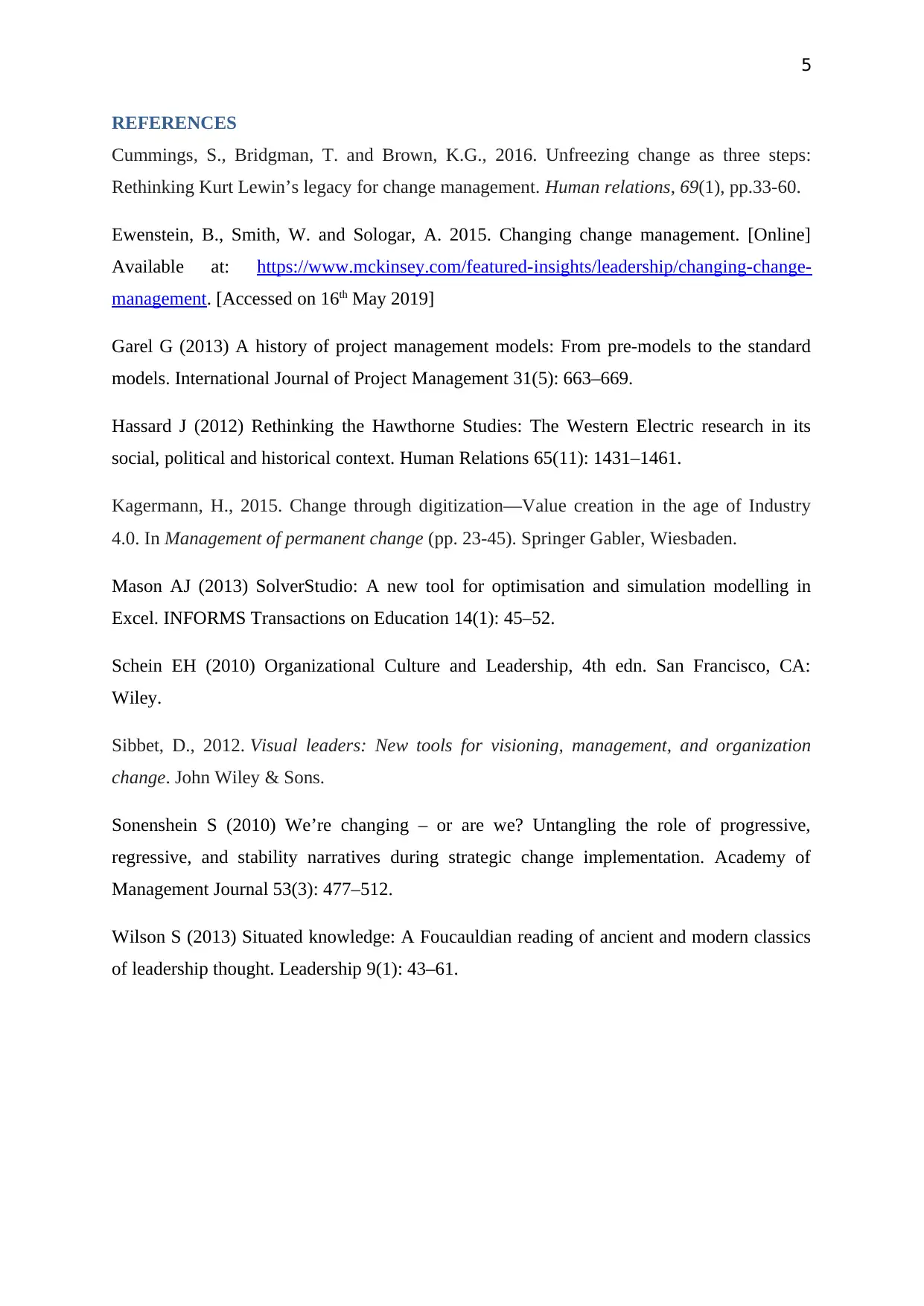
5
REFERENCES
Cummings, S., Bridgman, T. and Brown, K.G., 2016. Unfreezing change as three steps:
Rethinking Kurt Lewin’s legacy for change management. Human relations, 69(1), pp.33-60.
Ewenstein, B., Smith, W. and Sologar, A. 2015. Changing change management. [Online]
Available at: https://www.mckinsey.com/featured-insights/leadership/changing-change-
management. [Accessed on 16th May 2019]
Garel G (2013) A history of project management models: From pre-models to the standard
models. International Journal of Project Management 31(5): 663–669.
Hassard J (2012) Rethinking the Hawthorne Studies: The Western Electric research in its
social, political and historical context. Human Relations 65(11): 1431–1461.
Kagermann, H., 2015. Change through digitization—Value creation in the age of Industry
4.0. In Management of permanent change (pp. 23-45). Springer Gabler, Wiesbaden.
Mason AJ (2013) SolverStudio: A new tool for optimisation and simulation modelling in
Excel. INFORMS Transactions on Education 14(1): 45–52.
Schein EH (2010) Organizational Culture and Leadership, 4th edn. San Francisco, CA:
Wiley.
Sibbet, D., 2012. Visual leaders: New tools for visioning, management, and organization
change. John Wiley & Sons.
Sonenshein S (2010) We’re changing – or are we? Untangling the role of progressive,
regressive, and stability narratives during strategic change implementation. Academy of
Management Journal 53(3): 477–512.
Wilson S (2013) Situated knowledge: A Foucauldian reading of ancient and modern classics
of leadership thought. Leadership 9(1): 43–61.
REFERENCES
Cummings, S., Bridgman, T. and Brown, K.G., 2016. Unfreezing change as three steps:
Rethinking Kurt Lewin’s legacy for change management. Human relations, 69(1), pp.33-60.
Ewenstein, B., Smith, W. and Sologar, A. 2015. Changing change management. [Online]
Available at: https://www.mckinsey.com/featured-insights/leadership/changing-change-
management. [Accessed on 16th May 2019]
Garel G (2013) A history of project management models: From pre-models to the standard
models. International Journal of Project Management 31(5): 663–669.
Hassard J (2012) Rethinking the Hawthorne Studies: The Western Electric research in its
social, political and historical context. Human Relations 65(11): 1431–1461.
Kagermann, H., 2015. Change through digitization—Value creation in the age of Industry
4.0. In Management of permanent change (pp. 23-45). Springer Gabler, Wiesbaden.
Mason AJ (2013) SolverStudio: A new tool for optimisation and simulation modelling in
Excel. INFORMS Transactions on Education 14(1): 45–52.
Schein EH (2010) Organizational Culture and Leadership, 4th edn. San Francisco, CA:
Wiley.
Sibbet, D., 2012. Visual leaders: New tools for visioning, management, and organization
change. John Wiley & Sons.
Sonenshein S (2010) We’re changing – or are we? Untangling the role of progressive,
regressive, and stability narratives during strategic change implementation. Academy of
Management Journal 53(3): 477–512.
Wilson S (2013) Situated knowledge: A Foucauldian reading of ancient and modern classics
of leadership thought. Leadership 9(1): 43–61.
⊘ This is a preview!⊘
Do you want full access?
Subscribe today to unlock all pages.

Trusted by 1+ million students worldwide
1 out of 6
Related Documents
Your All-in-One AI-Powered Toolkit for Academic Success.
+13062052269
info@desklib.com
Available 24*7 on WhatsApp / Email
![[object Object]](/_next/static/media/star-bottom.7253800d.svg)
Unlock your academic potential
Copyright © 2020–2025 A2Z Services. All Rights Reserved. Developed and managed by ZUCOL.




